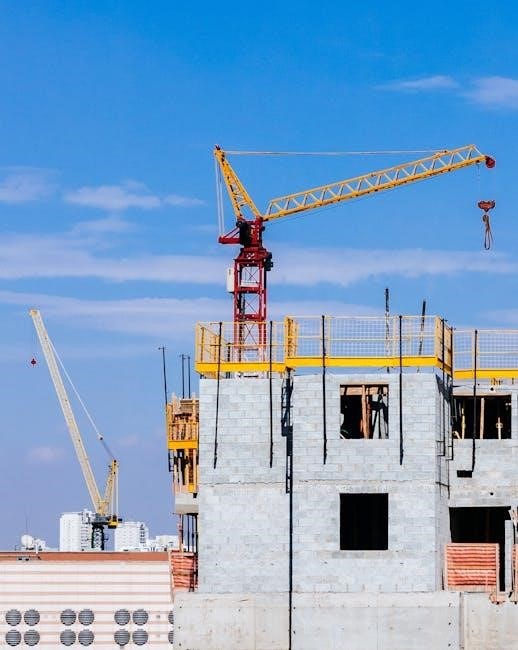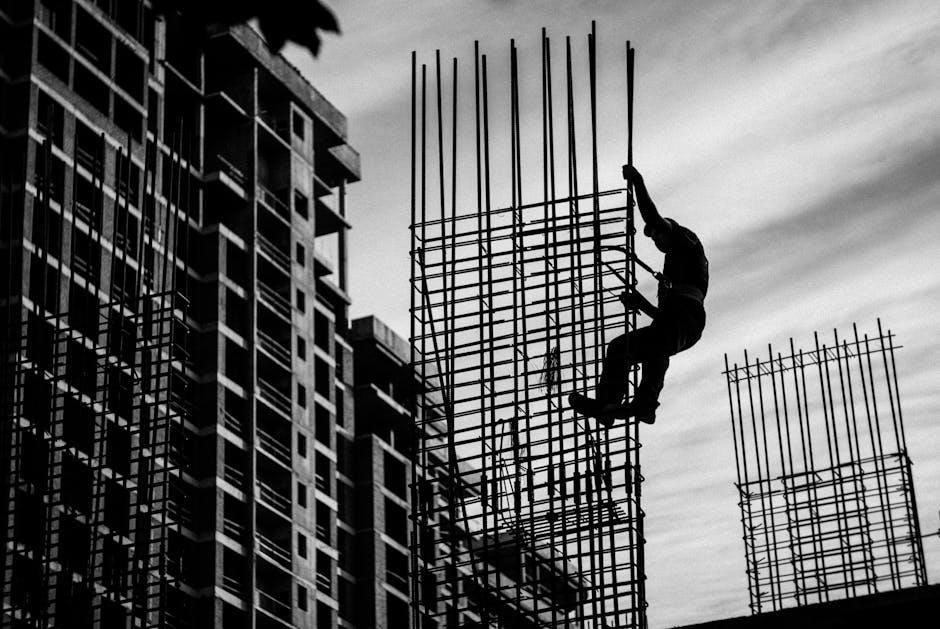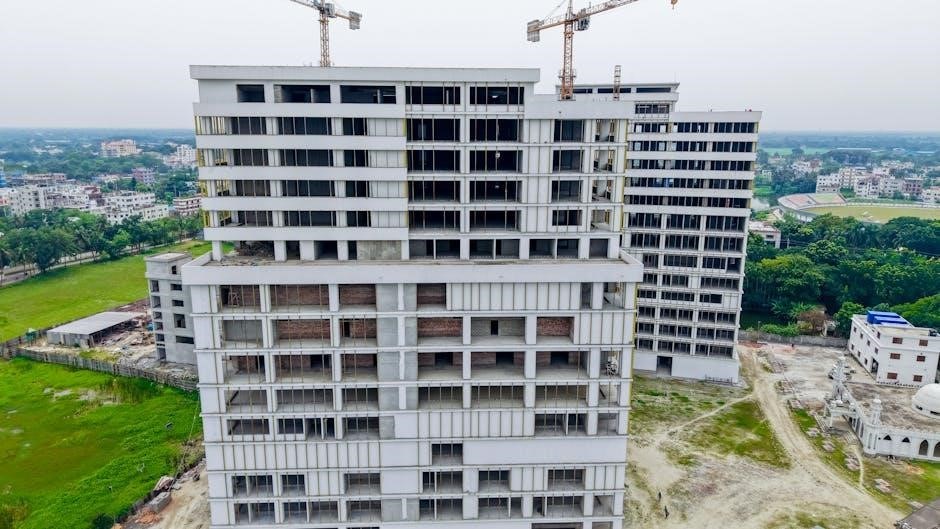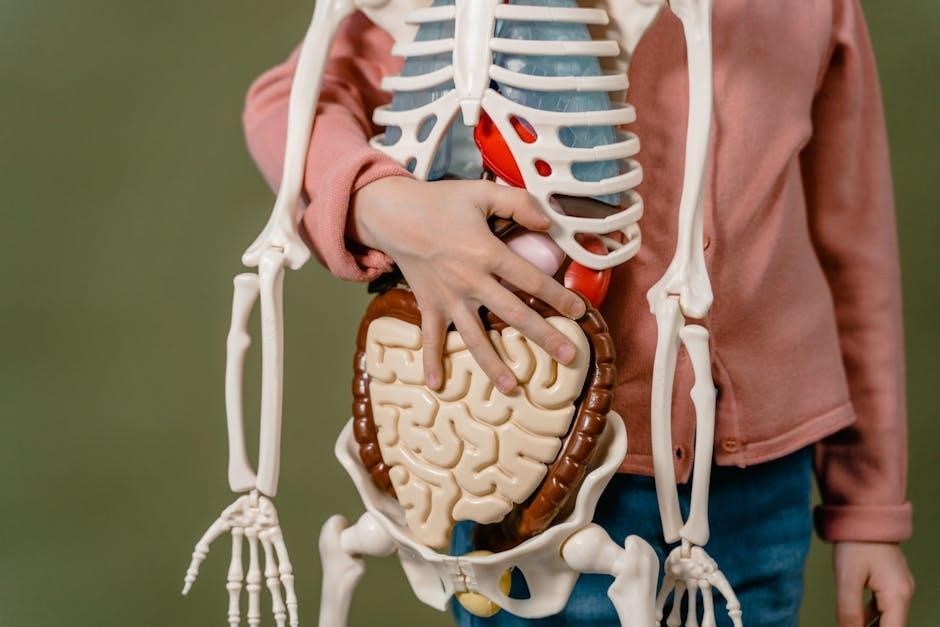Scaffolding is a temporary structure supporting construction and maintenance work, ensuring safety and efficiency. It consists of modular components like tubes, couplers, and frames, with manufacturers like Layher and BrandSafway leading innovation.
1.1. Definition and Purpose
Scaffolding is a temporary structure used to support construction, maintenance, or repair work. Its primary purpose is to provide a stable platform for workers and materials, ensuring safety and efficiency. Designed to be adaptable, scaffolding systems can be customized for various projects, from residential buildings to large industrial sites. The structure typically consists of frameworks, tubes, couplers, and boards, which are assembled to meet specific job requirements. Scaffolding plays a critical role in enabling safe access to heights, protecting both workers and the public. It is an essential tool in the construction industry, facilitating the completion of projects efficiently and securely. Proper installation and compliance with safety standards are vital for its effectiveness.
1.2. Importance in Construction

Scaffolding is indispensable in construction, enabling safe access to heights for workers and materials; It supports various tasks, from painting and repairs to new builds, ensuring projects are completed efficiently. By providing stable platforms, scaffolding minimizes risks of accidents and enhances productivity. Its adaptability allows it to be used in diverse settings, from residential sites to large-scale infrastructure projects. Properly erected scaffolding also protects the public by containing debris and equipment. As a critical component of site safety, it adheres to strict regulations, ensuring compliance with industry standards. Without scaffolding, modern construction would face significant challenges in maintaining worker safety and project efficiency. Its importance cannot be overstated in the building process.

Types of Scaffolding
Scaffolding comes in various forms, including modular, frame, and tube-and-clamp systems. Each type offers unique advantages, catering to different construction needs and site requirements effectively.
2.1. Modular Scaffolding
Modular scaffolding is a versatile and efficient system, offering ease of assembly and disassembly. It uses pre-fabricated components, such as frames and connectors, to create customizable structures. Ideal for complex projects, it provides flexibility in adapting to unique architectural designs. The modular design minimizes wasted materials and reduces erection time, making it cost-effective. Its durability and strength ensure safety for workers at heights. Regular maintenance ensures longevity, and its components are easily replaceable. Modular scaffolding is widely used in large-scale construction and renovation projects due to its adaptability and reliability. It is a preferred choice for ensuring stability and efficiency on site.
2.2. Frame Scaffolding
Frame scaffolding is a widely used system due to its simplicity and efficiency. It consists of pre-fabricated frames connected to form a sturdy structure. Lightweight yet durable, it is ideal for construction, renovation, and maintenance projects. The frames are typically made of steel or aluminum, ensuring strength and longevity. This type of scaffolding is easy to assemble and dismantle, making it a cost-effective option. Its modular design allows for flexibility, accommodating various heights and layouts. Frame scaffolding is also known for its safety features, providing a stable working platform for workers. It is a popular choice for projects requiring reliable and adaptable scaffolding solutions, ensuring both efficiency and safety on site.
2.3. Tube and Clamp Scaffolding
Tube and clamp scaffolding is a versatile and customizable system widely used in construction. It consists of steel tubes connected by clamps, allowing for flexible configurations to suit various project needs. This scaffolding type is ideal for irregular shapes and complex structures, offering adaptability and strength. The clamps provide secure connections, ensuring stability and safety. Tube and clamp scaffolding is commonly used for maintenance, repair, and construction projects where traditional systems may not fit. Its durability and ease of assembly make it a preferred choice for many contractors. Proper installation and regular inspection are crucial to ensure its safety and performance on site.
Key Components of Scaffolding
Tubes, couplers, frames, boards, base plates, and clamps are essential scaffolding parts, ensuring structural integrity and safety for workers during construction and maintenance projects.
3.1. Tubes and Poles
Tubes and poles form the structural backbone of scaffolding systems, providing the necessary height and stability for workers. Typically made from durable materials like steel or aluminum, these components are designed to withstand heavy loads and harsh weather conditions. Tubes are often used as vertical or horizontal supports, while poles serve as the primary uprights in the scaffold framework. Their strength and reliability are critical for ensuring the safety and efficiency of construction or maintenance projects. Proper sizing and material selection are essential to meet specific job requirements and safety standards.
3.2. Couplers
Couplers are essential connectors in scaffolding systems, designed to securely link tubes and other components together. They come in various types, such as right-angle, swivel, and sleeve couplers, each serving specific connection needs. These connectors ensure stability and structural integrity, allowing for versatile configurations to suit different project requirements. Durable materials like steel are commonly used to manufacture couplers, guaranteeing strength and reliability under heavy loads. Proper installation of couplers is critical to prevent instability and potential hazards, making them a cornerstone of safe and efficient scaffolding construction.
3.3. Frames
Frames are pre-fabricated structures used in scaffolding to provide a stable working platform. They are typically made of metal and come in standard sizes, offering a quick and efficient way to build scaffolding systems. Frames can be stacked vertically and horizontally to reach desired heights and lengths, ensuring flexibility for various construction projects. They are designed to support workers, tools, and materials safely, making them a fundamental component in scaffolding setups. Durable and reusable, frames are a cost-effective solution for temporary access during construction, renovation, or maintenance work, ensuring both functionality and reliability.
3.4. Boards and Platforms
Boards and platforms are essential scaffolding components that provide a stable working surface for laborers. Typically made of durable materials like wood or metal, they are designed to withstand heavy loads and ensure worker safety. Platforms are often adjustable, allowing them to be customized to various heights and configurations. They may include safety features such as guardrails and toe boards to prevent accidents. Proper installation and maintenance of boards and platforms are critical to ensure structural integrity and compliance with safety standards. These components are indispensable for enabling efficient and secure access to elevated work areas in construction and maintenance projects.
3.5. Base Plates and Jacks
Base plates and jacks are critical scaffolding components that ensure stability and proper leveling. Base plates are placed at the bottom of scaffolding towers to distribute weight evenly, preventing the structure from sinking or shifting. Jacks, also known as adjustable base plates, allow for height adjustments on uneven surfaces, ensuring the scaffolding remains level. Made from durable materials like steel, these components are essential for safety and structural integrity. Regular inspection and maintenance of base plates and jacks are vital to prevent accidents. They are often used in combination with other scaffolding parts to create a secure and stable working environment for construction projects.
3.6. Clamps

Clamps are essential scaffolding components used to secure and connect various parts. They provide structural integrity and stability by gripping poles and tubes firmly. Different types include right-angle clamps, swivel clamps, and sleeve couplers, each designed for specific connections. Made from durable materials like steel, clamps ensure long-term reliability. Regular inspection is crucial to identify wear and tear. Properly maintained clamps enhance safety by preventing accidental disengagement. They are fundamental in creating a secure and adaptable scaffolding system, allowing workers to perform tasks confidently at heights. Always follow manufacturer guidelines for installation and maintenance to ensure optimal performance and safety compliance.

Scaffolding Accessories
Scaffolding accessories enhance functionality, safety, and adaptability. They include components like ladder extensions, safety nets, and leveling feet, ensuring secure and efficient scaffold setups for various projects.
4.1. Safety Accessories
Safety accessories are essential for safeguarding workers and ensuring compliance with regulations. Guardrails and toe boards prevent falls, while harnesses and lanyards provide personal fall protection.Base plates and jack screws stabilize scaffolding, reducing collapse risks. Safety nets and debris meshes catch falling objects, protecting both workers and the public. Inspection tags and compliance labels ensure scaffolding meets safety standards and undergoes regular checks. These accessories are critical for maintaining a secure working environment and minimizing hazards on construction sites.
4.2. Fastening Components
Fastening components are critical for securing scaffolding structures, ensuring stability and safety. Common fasteners include screws, nuts, bolts, and washers, designed to withstand heavy loads. Couplers and clamps are used to connect tubes and frames, offering versatility in scaffolding assembly. These components are typically made from durable materials like steel or aluminum, providing long-lasting performance. Proper use of fastening components ensures the scaffolding remains stable, preventing structural failure. They are essential for both modular and traditional scaffolding systems, enabling quick and secure connections. Regular inspection of these components is vital to maintain safety standards and prevent accidents during construction operations.
4.3. Protective Equipment
Protective equipment is essential for ensuring the safety of workers when assembling, using, or dismantling scaffolding. Common items include hard hats, safety harnesses, and sturdy footwear. Safety nets and debris nets are also used to catch falling objects and prevent injuries. Personal protective equipment (PPE) like gloves and safety glasses shields workers from minor hazards. Harnesses with lanyards prevent falls from heights, while steel-toe boots protect against heavy objects. Regular inspection of PPE is crucial to maintain its effectiveness. Employers must provide suitable protective gear to comply with safety regulations and minimize workplace accidents. Proper use of protective equipment is a cornerstone of scaffolding safety practices worldwide.

Safety Guidelines for Scaffolding
Always ensure proper assembly, follow load capacity limits, and conduct regular inspections. Use safety harnesses, secure tools, and maintain clear access. Train workers and supervise operations to prevent accidents and ensure compliance with regulations.
5;1. Erection and Dismantling Safety
Ensure scaffolding is erected and dismantled by trained, competent personnel following manufacturer instructions. Conduct a hazard assessment, secure the structure, and use proper sequencing. Maintain stability, avoid overloading, and ensure all connections are secure. Use safety equipment like harnesses and ensure proper access. Supervise operations closely, especially near power lines or fragile surfaces. Plan dismantling to prevent sudden collapses, remove components systematically, and safely lower materials. Dispose of waste properly and store scaffolding parts securely post-dismantling. Adhere to safety guidelines to minimize risks and ensure compliance with industry standards.
5.2. Inspection and Maintenance
Regular inspection and maintenance are critical to ensure scaffolding safety and longevity. Inspect all components, including tubes, couplers, frames, and boards, for damage, rust, or wear. Check for loose connections, bent or dented parts, and ensure all moving components function smoothly. Clean and lubricate joints and clamps to prevent corrosion and seizing. Replace any damaged or worn-out parts immediately. Store scaffolding components in a dry, protected area when not in use. Maintain detailed records of inspections and maintenance activities. Always follow manufacturer guidelines and industry standards to ensure compliance and worker safety. Proper upkeep prevents accidents and extends the service life of scaffolding parts.

Leading Manufacturers of Scaffolding Parts
Top manufacturers include Altrad, HAKI, and PERI, known for high-quality, durable scaffolding systems. They focus on innovation and safety, offering reliable solutions for construction projects.
6.1. Layher
Layher is a global leader in scaffolding systems, renowned for its innovative and high-quality products. Their modular scaffolding solutions, such as the Allround and StarFrame systems, offer exceptional versatility and safety. Layher’s scaffolding parts are designed for durability and ease of use, catering to diverse construction needs. The company emphasizes adherence to international safety standards, making their products a preferred choice for contractors and rental companies worldwide. Layher’s commitment to innovation and customer satisfaction has solidified its position as a trusted name in the scaffolding industry, providing reliable solutions that enhance productivity and reduce costs on construction sites.
6.2. BrandSafway
BrandSafway is a leading global provider of scaffolding solutions, offering a wide range of systems and services. Known for their high-quality modular scaffolding, they cater to construction, industrial, and energy sectors. Their product portfolio includes innovative systems like the HAKI and Yuri modular scaffolding, designed for adaptability and efficiency. BrandSafway also provides rental services, ensuring flexibility for projects of varying scales. With a strong focus on safety, they offer comprehensive training programs and safety accessories to ensure compliance with industry standards. Their commitment to customer satisfaction and innovative solutions has made them a trusted partner for scaffolding needs worldwide.
6.3. Silica Industries
Silica Industries is a renowned manufacturer and supplier of high-quality scaffolding components, catering to construction and industrial sectors. Their product range includes modular scaffolding systems, frames, tubes, couplers, and accessories. Silica Industries emphasizes safety and durability, adhering to international standards. They offer customizable solutions to meet specific project requirements, ensuring versatility and efficiency. The company provides detailed PDF resources, such as product catalogs and technical specifications, to help clients identify and procure the right scaffolding parts. Their commitment to innovation and customer satisfaction has established them as a reliable partner for scaffolding needs in various industries worldwide.

Training and Certification
Training and certification programs are essential for ensuring safe scaffolding practices. These programs cover installation, maintenance, and inspection, providing workers with essential skills and knowledge.
7.1. Scaffolding Training Programs
Scaffolding training programs are designed to equip workers with essential skills for safe scaffolding operations. These programs typically include theoretical and practical sessions, covering topics like scaffolding components, safety regulations, and proper assembly techniques. Participants learn to identify scaffolding parts, understand load calculations, and adhere to industry standards. Many programs provide resources, such as PDF guides, that list and describe scaffolding parts, ensuring clarity and reference. Hands-on training allows learners to practice erecting and dismantling scaffolding safely. Certification is often awarded upon completion, confirming competency in scaffolding operations. These programs are crucial for ensuring worker safety and compliance with legal requirements.
7.2. Competency Requirements
Competency requirements for scaffolding operations ensure that workers possess the necessary skills and knowledge to handle scaffolding parts safely and effectively. These requirements typically include understanding scaffolding components, load-bearing capacities, and safety protocols. Workers must demonstrate proficiency in assembling, inspecting, and maintaining scaffolding structures. Familiarity with industry standards and regulations, such as OSHA guidelines, is essential. Employers often require certification or documented training as proof of competency. Practical assessments may also be conducted to verify a worker’s ability to identify and use scaffolding parts correctly. Meeting these requirements is critical for preventing accidents and ensuring compliance with legal and safety standards in construction environments.

PDF Resources for Scaffolding Parts
This section provides a collection of PDF resources, including comprehensive guides, technical specifications, and safety standards, to help professionals understand and utilize scaffolding parts effectively.
8.1. Comprehensive Guides
Comprehensive guides provide detailed insights into scaffolding parts, including their functions, installation, and safety protocols. These resources are essential for professionals to ensure safe and efficient scaffolding practices. They cover various scaffolding systems, such as modular, frame, and tube-and-clamp setups, offering step-by-step instructions. Many guides include diagrams and charts to visualize complex assemblies. Topics like load capacity, height restrictions, and material specifications are thoroughly explained. Additionally, these guides often align with industry standards, making them invaluable for compliance and best practices. They serve as a one-stop reference for contractors, engineers, and safety officers to manage scaffolding projects effectively.
8.2. Technical Specifications
Technical specifications for scaffolding parts are detailed documents outlining the precise requirements for each component. These specs ensure compatibility, safety, and performance, covering dimensions, material grades, and load-bearing capacities. They often include tolerances, finishing standards, and testing procedures to meet industry regulations. For instance, tube diameters, thicknesses, and coupler strengths are specified to guarantee structural integrity. These documents also provide installation parameters and weight limits, crucial for safe assembly. By adhering to these specifications, users can ensure scaffolding systems are reliable and compliant with safety standards. They serve as a blueprint for manufacturers and engineers to design and deploy scaffolding effectively.
8.3. Safety Manuals
Safety manuals for scaffolding parts provide critical guidelines to ensure safe installation, operation, and maintenance. These manuals outline proper erection techniques, load capacity limits, and emergency procedures to prevent accidents. They include detailed instructions for inspecting components, identifying hazards, and adhering to safety protocols. Compliance with OSHA and other regulatory standards is emphasized to minimize risks. Safety manuals also cover personal protective equipment (PPE) requirements and emergency response plans. They serve as essential resources for workers, supervisors, and contractors to uphold safety standards and prevent workplace incidents. Regular updates ensure alignment with evolving industry regulations and best practices.

Maintenance and Inspection
Regular checks ensure scaffolding stability and safety, evaluating components like tubes, couplers, and frames for damage or wear. Professionals inspect and address issues promptly.
9.1. Regular Maintenance Checks
Regular maintenance checks are essential to ensure scaffolding safety and durability. Inspect all components, including tubes, couplers, frames, and boards, for signs of damage or wear. Check for rust, dents, or bending that could compromise structural integrity. Clean debris and dirt that may obstruct connections or weaken stability. Tighten loose couplers and ensure all joints are secure. Replace any damaged or corroded parts immediately. Document findings and schedule routine inspections to maintain compliance with safety standards. Proper maintenance prevents accidents and extends the lifespan of scaffolding equipment, ensuring reliable performance on construction sites.
9.2. Inspection Tags and Compliance
Inspection tags are critical for ensuring scaffolding compliance with safety standards. These tags indicate whether the scaffolding is safe for use, having passed rigorous inspections. Attach tags to key access points, updating them after each inspection. Compliance involves adhering to local and international regulations, such as OSHA standards, to guarantee structural integrity. Regular inspections must be documented, and tags should reflect the most recent evaluation. Non-compliant scaffolding must be immediately repaired or restricted from use. Inspection tags provide clear communication about safety status, ensuring workers and supervisors are aware of potential risks. This system minimizes hazards and ensures a safe working environment on construction sites.
